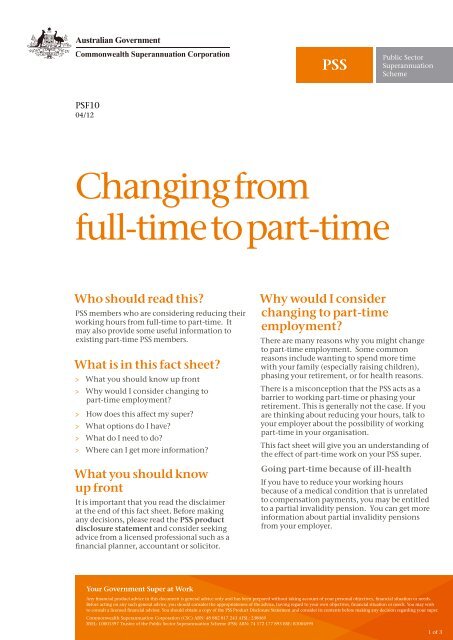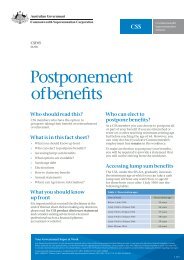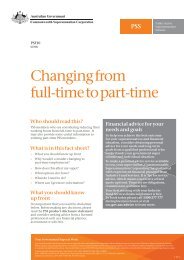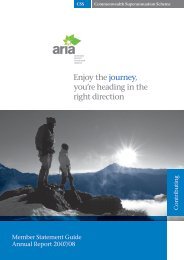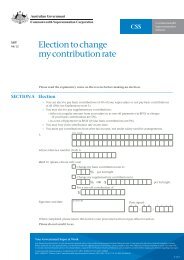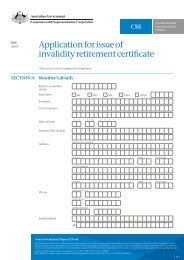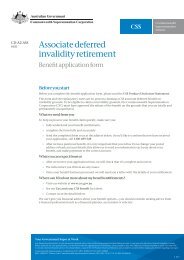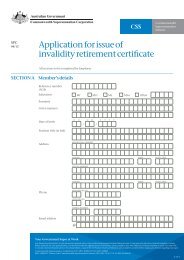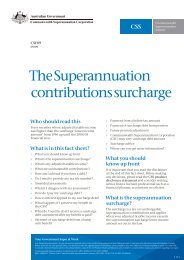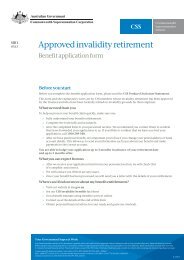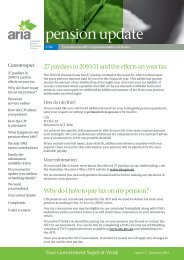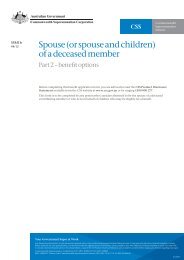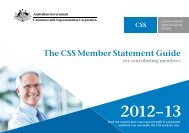Changing from full-time to part-time - PSS
Changing from full-time to part-time - PSS
Changing from full-time to part-time - PSS
Create successful ePaper yourself
Turn your PDF publications into a flip-book with our unique Google optimized e-Paper software.
PSF1004/12<strong>Changing</strong> <strong>from</strong><strong>full</strong>-<strong>time</strong> <strong>to</strong> <strong>part</strong>-<strong>time</strong>Who should read this?<strong>PSS</strong> members who are considering reducing theirworking hours <strong>from</strong> <strong>full</strong>-<strong>time</strong> <strong>to</strong> <strong>part</strong>-<strong>time</strong>. Itmay also provide some useful information <strong>to</strong>existing <strong>part</strong>-<strong>time</strong> <strong>PSS</strong> members.What is in this fact sheet?> > What you should know up front> > Why would I consider changing <strong>to</strong><strong>part</strong>-<strong>time</strong> employment?> > How does this affect my super?> > What options do I have?> > What do I need <strong>to</strong> do?> > Where can I get more information?What you should knowup frontIt is important that you read the disclaimerat the end of this fact sheet. Before makingany decisions, please read the <strong>PSS</strong> productdisclosure statement and consider seekingadvice <strong>from</strong> a licensed professional such as afinancial planner, accountant or solici<strong>to</strong>r.Why would I considerchanging <strong>to</strong> <strong>part</strong>-<strong>time</strong>employment?There are many reasons why you might change<strong>to</strong> <strong>part</strong>-<strong>time</strong> employment. Some commonreasons include wanting <strong>to</strong> spend more <strong>time</strong>with your family (especially raising children),phasing your retirement, or for health reasons.There is a misconception that the <strong>PSS</strong> acts as abarrier <strong>to</strong> working <strong>part</strong>-<strong>time</strong> or phasing yourretirement. This is generally not the case. If youare thinking about reducing your hours, talk <strong>to</strong>your employer about the possibility of working<strong>part</strong>-<strong>time</strong> in your organisation.This fact sheet will give you an understanding ofthe effect of <strong>part</strong>-<strong>time</strong> work on your <strong>PSS</strong> super.Going <strong>part</strong>-<strong>time</strong> because of ill-healthIf you have <strong>to</strong> reduce your working hoursbecause of a medical condition that is unrelated<strong>to</strong> compensation payments, you may be entitled<strong>to</strong> a <strong>part</strong>ial invalidity pension. You can get moreinformation about <strong>part</strong>ial invalidity pensions<strong>from</strong> your employer.Your Government Super at WorkAny financial product advice in this document is general advice only and has been prepared without taking account of your personal objectives, financial situation or needs.Before acting on any such general advice, you should consider the appropriateness of the advice, having regard <strong>to</strong> your own objectives, financial situation or needs. You may wish<strong>to</strong> consult a licensed financial advisor. You should obtain a copy of the <strong>PSS</strong> Product Disclosure Statement and consider its contents before making any decision regarding your super.Commonwealth Superannuation Corporation (CSC) ABN: 48 882 817 243 AFSL: 238069RSEL: L0001397 Trustee of the Public Sec<strong>to</strong>r Superannuation Scheme (<strong>PSS</strong>) ABN: 74 172 177 893 RSE: R10045951 of 3
If you reduced your hours because of a medicalcondition and a <strong>part</strong>ial invalidity pension wasgranted, your benefit accrual would continueat the <strong>full</strong>-<strong>time</strong> rate despite the fact that yourcontributions would be at the <strong>part</strong>-<strong>time</strong> rate.How does this affectmy super?The effect on your contributionsIf you become a <strong>part</strong>-<strong>time</strong> employee there isno effect on your fortnightly contribution rateuntil your next birthday. At that <strong>time</strong>, we workout your contribution rate similarly <strong>to</strong> if youwere contributing on a <strong>full</strong>-<strong>time</strong> basis. However,your contributions would be reduced pro-rataaccording <strong>to</strong> the number of hours you areapproved <strong>to</strong> work on your birthday.The following table shows the differentbenefit multiples that apply <strong>to</strong> different ratesof contribution.Contribution rateAnnual accrual rate0% .11 x FAS (or 11% of FAS)2 % .15 x FAS (or 15% of FAS)3% .17 x FAS (or 17% of FAS)4 % .19 x FAS (or 19% of FAS)5% .21 x FAS (or 21% of FAS)6 % .23 x FAS (or 23% of FAS)7% .25 x FAS (or 25% of FAS)8 % .27 x FAS (or 27% of FAS)9 % .29 x FAS (or 29% of FAS)10 % .31 x FAS (or 31% of FAS)ExampleMaria, a <strong>full</strong>-<strong>time</strong> employee is receiving asalary for superannuation purposes of$45,361. She is paying 7% of this incontributions <strong>to</strong> the <strong>PSS</strong>. Her contributionrate is worked out as follows:$45,361 ÷ 26 × 7% = $122.13 per fortnightMaria becomes a <strong>part</strong>-<strong>time</strong> employee andworks 50 of her normal 73.5 <strong>full</strong>-<strong>time</strong> hoursfor the position. Her contributions are workedout as follows:Step 1: Work out the <strong>full</strong>-<strong>time</strong> contribution$45,361 ÷ 26 × 7% = $122.13 per fortnightStep 2: Pro-rata the contribution according<strong>to</strong> the approved <strong>part</strong>-<strong>time</strong> hours$122.13 x 50 ÷ 73.5 = $83.08 per fortnightThe effect on my benefitThe <strong>PSS</strong> is a defined benefit scheme and benefitsare based on a number of fac<strong>to</strong>rs, including yourlength of membership, your salary and your rateof contribution.To work out your benefit, you must first work outyour Final Average Salary (FAS). This is generallythe average of your salaries on each of the threebirthdays before you leave the <strong>PSS</strong>. The salariesused are always the <strong>full</strong>-<strong>time</strong> equivalent andyour FAS will not be reduced if you were <strong>to</strong> go<strong>part</strong>-<strong>time</strong>.So, in Maria’s case, as a <strong>full</strong>-<strong>time</strong> employee, if sheelected <strong>to</strong> pay contributions at a rate of 7% overa 12-month period, her benefit multiple for ayear would be 0.25 of her final average salary.Going <strong>part</strong>-<strong>time</strong> does not affect any benefitmultiple that you accrued while a <strong>full</strong>-<strong>time</strong>contribu<strong>to</strong>r. It may affect any future multipleaccrual though.Benefit accrual for permanent <strong>part</strong>-<strong>time</strong>employeesIf you were <strong>to</strong> go <strong>part</strong>-<strong>time</strong>, your ongoingmultiple accrual <strong>from</strong> your next birthday wouldbe reduced pro-rata according <strong>to</strong> the approvedhours worked on your next birthday. Thereduction does not apply <strong>to</strong> the multiple youhad already accrued before your next birthday.The following formula would be used <strong>to</strong>calculate your <strong>part</strong>-<strong>time</strong> multiple accrual:Benefit multiple x<strong>part</strong>-<strong>time</strong> hours<strong>full</strong>-<strong>time</strong> hoursTherefore, if Maria’s <strong>part</strong>-<strong>time</strong> hours (asapproved at her last birthday) were 50 hoursa fortnight, and her <strong>full</strong>-<strong>time</strong> hours for thatposition were 73.5 hours per fortnight, the yearlymultiple accrual would be:0.25 × 50 ÷ 73.5 = 0.17PSF 24 / February 2005Then, you multiply your FAS by your benefitmultiple. Your benefit multiple accruesaccording <strong>to</strong> your rate of contribution. Yourbenefit multiple actually grows each fortnightwith each contribution you make.2 of 3Your Government Super at Work2 of 3
Calculation of benefit multipleThe following examples show the effect thatworking <strong>part</strong>-<strong>time</strong> has on the accrual of yourbenefit multiple. Maria retires after 30 years’membership. Her FAS is $45,361.In Example 1, Maria worked <strong>full</strong>-<strong>time</strong> for thelength of her membership. During this periodshe contributed 5% for 10 years, 6% for 15 yearsand 7% for five years.In Example 2, Maria worked <strong>full</strong>-<strong>time</strong> for 25years, contributing at rates of 5% for 10 years and6% for 15 years. She also worked <strong>part</strong>-<strong>time</strong> (50hours per fortnight) for five years, during which<strong>time</strong> she paid 7% in contributions.Maria’s lump sum benefit would be worked outas follows:Example 110 years × 0.21 (see table above) = 2.1015 years × 0.23 (see table above) = 3.455 years × 0.25 (see table above) = 1.25Total Benefit Multiple = 6.806.80 × $45,361 (FAS) = $308,455Example 210 years × 0.21 = 2.1015 years × 0.23 = 3.455 years (<strong>part</strong>-<strong>time</strong>) × 0.17 = 0.85Total Benefit Multiple = 6.406.40 × $45,361 (FAS) = $290,310Does going <strong>part</strong>-<strong>time</strong> affect invalidityand death benefits?In the <strong>PSS</strong>, you generally have au<strong>to</strong>maticinvalidity and death cover. In some situations,you can also purchase additional death andinvalidity cover.Your au<strong>to</strong>matic cover consists of your currentbenefit accrual plus a prospective element that iscalculated as if you had continued <strong>to</strong> contributeuntil your 60th birthday. Going <strong>part</strong>-<strong>time</strong>may reduce the prospective element of yourdeath and invalidity benefit in addition <strong>to</strong> thereduction in your ongoing accrual.What options do I have?As a <strong>part</strong>-<strong>time</strong> employee, you can elect <strong>to</strong>change your contribution rate in the same wayas you can when you are a <strong>full</strong>-<strong>time</strong> employee.However, you cannot elect <strong>to</strong> continue paying<strong>full</strong>-<strong>time</strong> contributions.If you are reducing your hours due <strong>to</strong> healthreasons, you may be entitled <strong>to</strong> a <strong>part</strong>ialinvalidity pension. You will need <strong>to</strong> talk <strong>to</strong>your personnel section <strong>to</strong> discuss this option.What do I need <strong>to</strong> do?If you would like <strong>to</strong> reduce the hours that youare working, contact your employer for moreinformation.If you do go <strong>part</strong>-<strong>time</strong>, there is nothing youwould need <strong>to</strong> do in relation <strong>to</strong> your <strong>PSS</strong> super.Your employer will provide details of your<strong>part</strong>-<strong>time</strong> hours and we will au<strong>to</strong>maticallyreduce your contributions <strong>from</strong> your nextbirthday provided that you are still working<strong>part</strong>-<strong>time</strong>.As contributions would remain at the <strong>full</strong>-<strong>time</strong>rate until your next birthday, you may wish<strong>to</strong> reduce your rate of contributions <strong>to</strong> giveyou a little more take home pay. Rememberthough, that any reduction in the rate of yourcontributions affects the amount of multiplethat you are accruing.Where can I get moreinformation?The <strong>PSS</strong> website also has the i-Estima<strong>to</strong>r. Thei-Estima<strong>to</strong>r is a handy online <strong>to</strong>ol that enablesyou <strong>to</strong> estimate your future super benefits. Youwill need <strong>to</strong> have your Access Number* <strong>to</strong> usethe i-Estima<strong>to</strong>r.*To get an Access Number, call us on1300 000 377 and we can provide one overthe phone.EMAIL members@pss.gov.auPHONE 1300 000 377FAX 02 6272 9613MAILWEB<strong>PSS</strong>GPO Box 2252Canberra City ACT 2601www.pss.gov.auemailphonettypostmembers@pss.gov.auwebwww.pss.gov.au1300 000 377overseas callers+61 2 6272 9622(02) 6272 9827fax(02) 6272 9613<strong>PSS</strong>GPO Box 2252Canberra City ACT 26013 of 3


